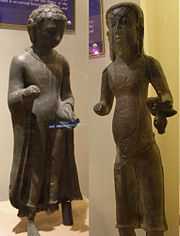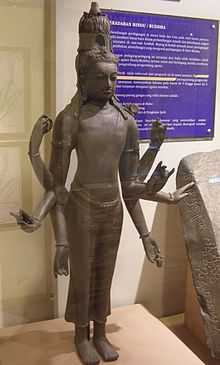
6th century Buddha statues (left) found at
Ipoh. 9th century
Hindu priest teacher statue found at Jalong, Perak.
Gangga Negara is believed to be a lost semi-legendary Hindu kingdom mentioned in the Malay Annals that covered present day Beruas, Dinding and Manjung in the state of Perak, Malaysia with Raja Gangga Shah Johan as one of its kings. Researchers believe that the kingdom was centered at Beruas and it collapsed after an attack by King Rajendra Chola I of Coromandel, South India, between 1025 and 1026. Another Malay annals Hikayat Merong Mahawangsa known as Kedah Annals, Gangga Negara may have been founded by Merong Mahawangsa's son Raja Ganjil Sarjuna of Kedah, allegedly a descendant of Alexander the Great or by the Khmer royalties no later than the 2nd century.
Origin

A photo taken from the
National History Museum of Kuala Lumpur. An 8th-9th century bronze standing 8-armed Buddhist Avalokitesvara statue found at Anglo Oriental,
Bidor, Perak tin mine in year 1936. 79cm height.
Gangga Negara means "a city on the Ganges" in Sanskrit,[1] the name derived[citation needed] from Ganganagar in northwest India where the Kambuja peoples inhabited. The Kambujas are an Indo-Iranian clan of the Indo-European family, originally localized in Pamirs and Badakshan. Commonly known as Hindu traders, they built their colonies[citation needed] in Southeast Asia around 2000 years ago at the Mekong valley and also at the Malay archipelago in Funan, Chenla, Champa, Khmer, Angkor, Langkasuka, Sailendra, Srivijaya, etc. Historians found the Kambuja traders travelled from Gujarat to Sri Lanka and then to Ligor (Nakhon Sri Thammarat) of the northern Malay peninsular, overland to Thailand and Cambodia.
Beruas
The first research into the Beruas kingdom was conducted by Colonel James Low in 1849 and a century later, by H.G. Quaritch Wales. According to the Museum and Antiquities Department, both researchers agreed that the Gangga Negara kingdom existed between 100 ce - 1000 [2] but could not ascertain the exact site. For years, villagers had unearthed artefacts, including tombstones with inscriptions that indicated that Beruas could have been the starting point for the spread of Islam in Peninsular Malaysia. Most of the artefacts, believed to be from the ancient kingdoms, are today displayed at the Beruas Museum dated back to the 5th and the 6th century. Artefacts on display include a 128 kg cannon, swords, kris, coins, tin ingots, pottery from the Ming Dynasty and various eras, and large jars.[3] Through these artifacts, it has been postulated that Pengkalan (Ipoh), Kinta Valley, Tanjung Rambutan, Bidor and Sungai Siput were part of the kingdom. Artifacts also suggest that the kingdom's center might have shifted several times. Gangga Negara was renamed to Beruas after the establishment of Islam there.
Beruas tree
The district of Beruas has found some royal Acehnese gravestones and this evidence has it linked to another historical source that a prince from Aceh of Sumatra rested at Beruas tree (Pokok Beruas), his name was Malik. History of Pasai did mentioned a Malik ul Salih who was the first local Hindu Malay king to convert to Islam in 1267. Today the beruas trees have become extinct but can still be found in the nearby villages of Pengkalan Baru and Batang Kubu .
References
- ↑ S. Durai Raja Singam Printed by Liang Khoo Printing Co., 1962 -Language Arts & Disciplines -253 pages
- ↑ Research on the Early Malay Doctors 1900-1957 Malaya and Singapore, By Faridah Abdul Rashid
- ↑ Neutron radiography: proceedings of the second world conference, Paris, France, June 16-20, 1986 John Penrose Barton, Commission of the European Communities, D. Reidel, 1987 -928 pages
External links


